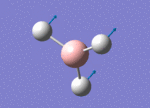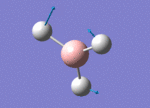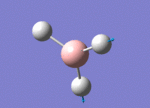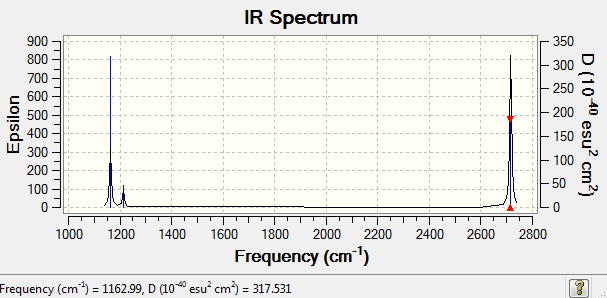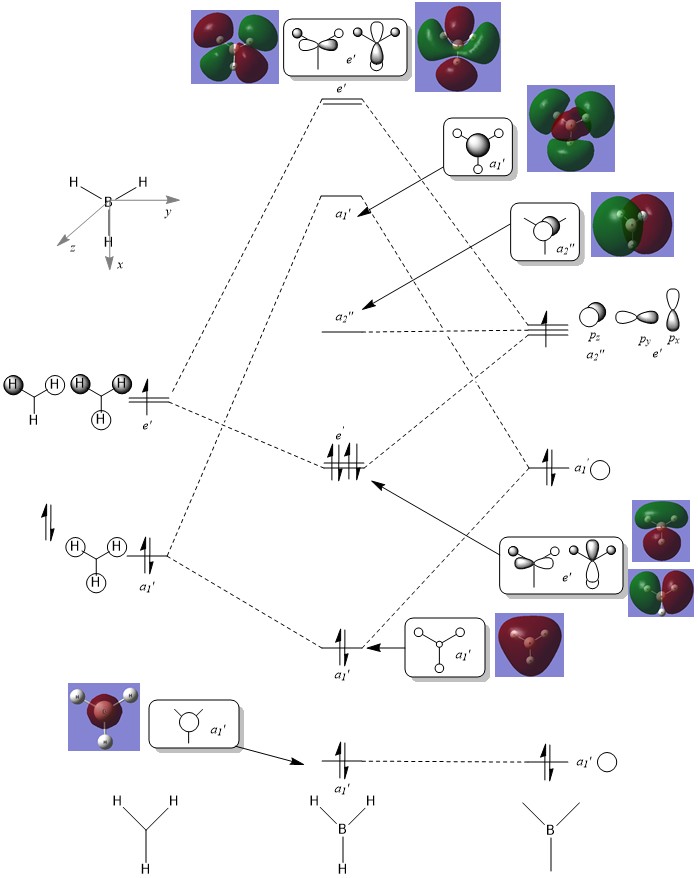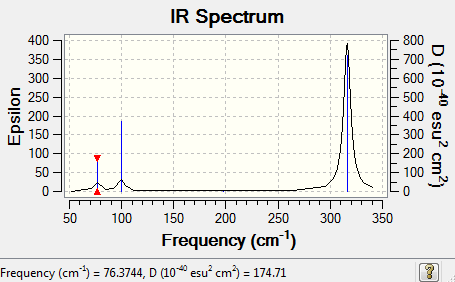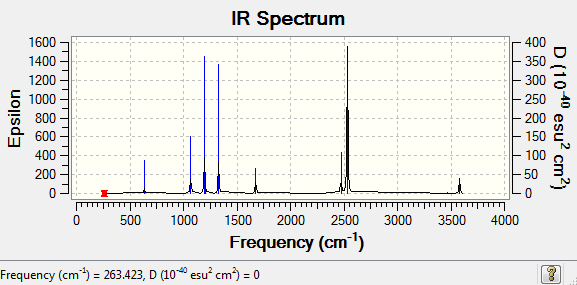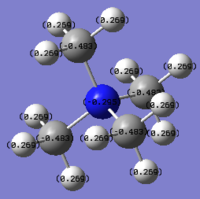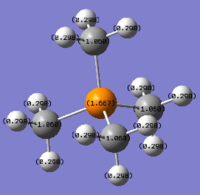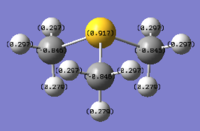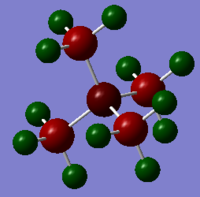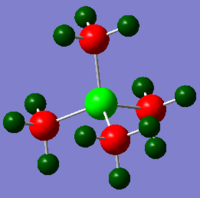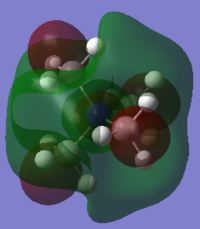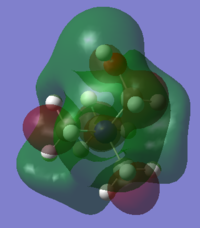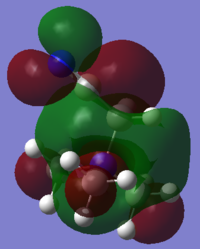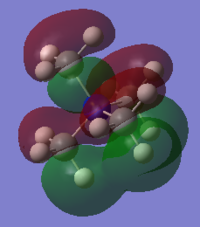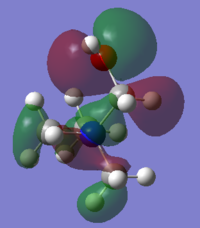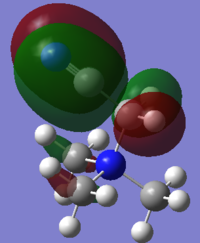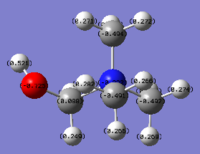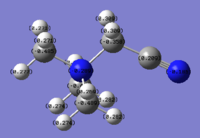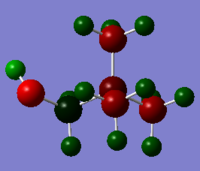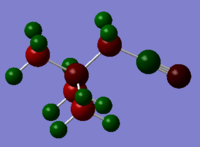User:Sw2711
Week 1 Inorganic computational
BH3
BH3 optimisation
| File Name | SW_BH3_OPT | |
|---|---|---|
| File Type | .log | |
| Calculation Type | FOPT | |
| Calculation Method | RB3LYP | |
| Basis Set | 3-21G | |
| Change | 0 | |
| Spin | Singlet | |
| E(RB3LYP) | -26.46226429 | a.u. |
| RMS Gradient Norm | 0.00008851 | a.u. |
| Imaginary Freq | ||
| Dipole Moment | 0.0003 | Debye |
| Point Group | CS | |
| Job cpu time: 0 days 0 hours 0 minutes 20.0 seconds. |
BH3 Optimisation
Item Value Threshold Converged?
Maximum Force 0.000220 0.000450 YES
RMS Force 0.000106 0.000300 YES
Maximum Displacement 0.000940 0.001800 YES
RMS Displacement 0.000447 0.001200 YES
Predicted change in Energy=-1.672479D-07
Optimization completed.
-- Stationary point found.
----------------------------
! Optimized Parameters !
! (Angstroms and Degrees) !
-------------------------- --------------------------
! Name Definition Value Derivative Info. !
--------------------------------------------------------------------------------
! R1 R(1,2) 1.1948 -DE/DX = -0.0002 !
! R2 R(1,3) 1.1947 -DE/DX = -0.0002 !
! R3 R(1,4) 1.1944 -DE/DX = -0.0001 !
! A1 A(2,1,3) 120.0157 -DE/DX = 0.0 !
! A2 A(2,1,4) 119.986 -DE/DX = 0.0 !
! A3 A(3,1,4) 119.9983 -DE/DX = 0.0 !
! D1 D(2,1,4,3) 180.0 -DE/DX = 0.0 !
--------------------------------------------------------------------------------
GradGradGradGradGradGradGradGradGradGradGradGradGradGradGradGradGradGrad
| File Name | SW_bh3_opt_631G | |
|---|---|---|
| File Type | .log | |
| Calculation Type | FOPT | |
| Calculation Method | RB3LYP | |
| Basis Set | 6-31G(d,p) | |
| Change | 0 | |
| Spin | Singlet | |
| E(RB3LYP) | -26.61532358 | a.u. |
| RMS Gradient Norm | 0.00008206 | a.u. |
| Imaginary Freq | ||
| Dipole Moment | 0.0003 | Debye |
| Point Group | CS | |
| Job cpu time: 0 days 0 hours 0 minutes 14.0 seconds. | ||
| Optimised Bond Length | 1.19, 1.19, 1.19 | Å |
| Optimised Bond Angle | 120.0, 120.0, 120.0 |
BH3 Optimisation 631G
Item Value Threshold Converged?
Maximum Force 0.000204 0.000450 YES
RMS Force 0.000099 0.000300 YES
Maximum Displacement 0.000875 0.001800 YES
RMS Displacement 0.000418 0.001200 YES
Predicted change in Energy=-1.452086D-07
Optimization completed.
-- Stationary point found.
----------------------------
! Optimized Parameters !
! (Angstroms and Degrees) !
-------------------------- --------------------------
! Name Definition Value Derivative Info. !
--------------------------------------------------------------------------------
! R1 R(1,2) 1.1928 -DE/DX = -0.0002 !
! R2 R(1,3) 1.1926 -DE/DX = -0.0002 !
! R3 R(1,4) 1.1924 -DE/DX = 0.0 !
! A1 A(2,1,3) 120.0146 -DE/DX = 0.0 !
! A2 A(2,1,4) 119.9866 -DE/DX = 0.0 !
! A3 A(3,1,4) 119.9988 -DE/DX = 0.0 !
! D1 D(2,1,4,3) 180.0 -DE/DX = 0.0 !
--------------------------------------------------------------------------------
GradGradGradGradGradGradGradGradGradGradGradGradGradGradGradGradGradGrad
BH3 optimisation 631G 2nd time
| File Name | BH3_OPT_3 | |
|---|---|---|
| File Type | .log | |
| Calculation Type | FOPT | |
| Calculation Method | RB3LYP | |
| Basis Set | 6-31G(d,p) | |
| Change | 0 | |
| Spin | Singlet | |
| E(RB3LYP) | -26.61532364 | a.u. |
| RMS Gradient Norm | 0.00000000 | a.u. |
| Imaginary Freq | ||
| Dipole Moment | 0.0000 | Debye |
| Point Group | D3H | |
| Job cpu time: 0 days 0 hours 0 minutes 9.0 seconds. | ||
| Optimised Bond Length | 1.19, 1.19, 1.19 | Å |
| Literature Bond Lengthlit 2 | 1.2325 | Å |
| Optimised Bond Angle | 120.0, 120.0, 120.0 |
BH3 Optimisation 2nd time
Item Value Threshold Converged?
Maximum Force 0.000000 0.000002 YES
RMS Force 0.000000 0.000001 YES
Maximum Displacement 0.000000 0.000006 YES
RMS Displacement 0.000000 0.000004 YES
Predicted change in Energy=-1.214719D-18
Optimization completed.
-- Stationary point found.
----------------------------
! Optimized Parameters !
! (Angstroms and Degrees) !
-------------------------- --------------------------
! Name Definition Value Derivative Info. !
--------------------------------------------------------------------------------
! R1 R(1,2) 1.1923 -DE/DX = 0.0 !
! R2 R(1,3) 1.1923 -DE/DX = 0.0 !
! R3 R(1,4) 1.1923 -DE/DX = 0.0 !
! A1 A(2,1,3) 120.0 -DE/DX = 0.0 !
! A2 A(2,1,4) 120.0 -DE/DX = 0.0 !
! A3 A(3,1,4) 120.0 -DE/DX = 0.0 !
! D1 D(2,1,4,3) 180.0 -DE/DX = 0.0 !
--------------------------------------------------------------------------------
GradGradGradGradGradGradGradGradGradGradGradGradGradGradGradGradGradGrad
BH3 Frequency
| File Name | SW_BH3_FREQ | |
|---|---|---|
| File Type | .log | |
| Calculation Type | FREQ | |
| Calculation Method | RB3LYP | |
| Basis Set | 6-31G(d,p) | |
| Change | 0 | |
| Spin | Singlet | |
| E(RB3LYP) | -26.61532358 | a.u. |
| RMS Gradient Norm | 0.00008199 | a.u. |
| Imaginary Freq | 0 | |
| Dipole Moment | 0.0003 | Debye |
| Point Group | CS | |
| Job cpu time: 0 days 0 hours 0 minutes 11.0 seconds. |
BH3 Frequency Low frequencies --- 0.0006 0.0007 0.0007 33.8245 41.5797 43.6874 Low frequencies --- 1163.5016 1213.4680 1213.5880
comment since the frequency is too high. Therefore point group constraint is added to run a 2nd time.
BH3 Frequency 2nd
| File Name | BH3_FREQ_3 | |
|---|---|---|
| File Type | .log | |
| Calculation Type | FREQ | |
| Calculation Method | RB3LYP | |
| Basis Set | 6-31G(d,p) | |
| Change | 0 | |
| Spin | Singlet | |
| E(RB3LYP) | -26.61532364 | a.u. |
| RMS Gradient Norm | 0.00000001 | a.u. |
| Imaginary Freq | 0 | |
| Dipole Moment | 0.0000 | Debye |
| Point Group | D3H | |
| Job cpu time: 0 days 0 hours 0 minutes 6.0 seconds. |
BH3 Frequency Low frequencies --- -9.3741 -9.3588 -0.0753 0.0007 0.5350 2.4499 Low frequencies --- 1162.9902 1213.1495 1213.1497
BH3 Vibration
In your wiki also explain why are there less than six peaks in the spectrum, when there are obviously six vibrations.
There are indeed six vibrational modes shown in the table. However, the No.2 and No.3 both have frequency at 1213 cm-1 and No. 5 and No. 6 both have the same frequency at 2716 cm-1. So they overlap to each other and only appear two peaks. On the other hand, the vibration of No. 4 is zero, as it is symmetrical stretching and no change in dipole. So it is IR inactive. Therefore there are only 3 peaks appear in the spectrum.
Molecular Orbital of BH3
[Molecular Orbital of BH3 D space]
Answer the following questions:
Are there any significant differences between the real and LCAO MOs?
What does this say about the accuracy and usefulness of qualitative MO theory?
GaBr3
GaBr3 optimisation
| File Name | SW_GABR3_OPT | |
|---|---|---|
| File Type | .log | |
| Calculation Type | FOPT | |
| Calculation Method | RB3LYP | |
| Basis Set | LANL2DZ | |
| Change | 0 | |
| Spin | Singlet | |
| E(RB3LYP) | -41.70082783 | a.u. |
| RMS Gradient Norm | 0.00000016 | a.u. |
| Imaginary Freq | ||
| Dipole Moment | 0.0000 | Debye |
| Point Group | D3H | |
| Job cpu time: 0 days 0 hours 0 minutes 6.0 seconds. | ||
| Optimised Bond Length | 2.35, 2.35, 2.35 | Å |
| Literature Bond Lengthlit 2 | 2.3525 | Å |
| Optimised Bond Angle | 120.0, 120.0, 120.0 |
GaBr3 optimisation
Item Value Threshold Converged?
Maximum Force 0.000000 0.000450 YES
RMS Force 0.000000 0.000300 YES
Maximum Displacement 0.000003 0.001800 YES
RMS Displacement 0.000002 0.001200 YES
Predicted change in Energy=-1.282691D-12
Optimization completed.
-- Stationary point found.
----------------------------
! Optimized Parameters !
! (Angstroms and Degrees) !
-------------------------- --------------------------
! Name Definition Value Derivative Info. !
--------------------------------------------------------------------------------
! R1 R(1,2) 2.3502 -DE/DX = 0.0 !
! R2 R(1,3) 2.3502 -DE/DX = 0.0 !
! R3 R(1,4) 2.3502 -DE/DX = 0.0 !
! A1 A(2,1,3) 120.0 -DE/DX = 0.0 !
! A2 A(2,1,4) 120.0 -DE/DX = 0.0 !
! A3 A(3,1,4) 120.0 -DE/DX = 0.0 !
! D1 D(2,1,4,3) 180.0 -DE/DX = 0.0 !
--------------------------------------------------------------------------------
GradGradGradGradGradGradGradGradGradGradGradGradGradGradGradGradGradGrad
GaBr3 Frequency
| File Name | SW_GABR3_FREQ | |
|---|---|---|
| File Type | .log | |
| Calculation Type | FREQ | |
| Calculation Method | RB3LYP | |
| Basis Set | LANL2DZ | |
| Change | 0 | |
| Spin | Singlet | |
| E(RB3LYP) | -41.70082783 | a.u. |
| RMS Gradient Norm | 0.00000011 | a.u. |
| Imaginary Freq | 0 | |
| Dipole Moment | 0.0000 | Debye |
| Point Group | D3H | |
| Job cpu time: 0 days 0 hours 0 minutes 6.0 seconds. |
GaBr<sub>3</sub> Frequency Low frequencies --- -0.5252 -0.5247 -0.0024 -0.0010 0.0235 1.2010 Low frequencies --- 76.3744 76.3753 99.6982
GaBr3_IRspectrum
BBr3
BBr3 optimisation
| File Name | SW_BBr3_OPT_GEN | |
|---|---|---|
| File Type | .log | |
| Calculation Type | FOPT | |
| Calculation Method | RB3LYP | |
| Basis Set | Gen | |
| Change | 0 | |
| Spin | Singlet | |
| E(RB3LYP) | -64.43644666 | a.u. |
| RMS Gradient Norm | 0.00001415 | a.u. |
| Imaginary Freq | ||
| Dipole Moment | 0.0003 | Debye |
| Point Group | CS | |
| Job cpu time: 0 days 0 hours 0 minutes 15.0 seconds. | ||
| Optimised Bond Length | 1.93, 1.93, 1.93 | Å |
| Literature Bond Lengthlit 2 | 1.893 | Å |
| Optimised Bond Angle | 120.0, 120.0, 120.0 | |
| Reference*** | 2.35018 |
BBr3 optimisation
Item Value Threshold Converged?
Maximum Force 0.000026 0.000450 YES
RMS Force 0.000012 0.000300 YES
Maximum Displacement 0.000131 0.001800 YES
RMS Displacement 0.000065 0.001200 YES
Predicted change in Energy=-3.258105D-09
Optimization completed.
-- Stationary point found.
----------------------------
! Optimized Parameters !
! (Angstroms and Degrees) !
-------------------------- --------------------------
! Name Definition Value Derivative Info. !
--------------------------------------------------------------------------------
! R1 R(1,2) 1.934 -DE/DX = 0.0 !
! R2 R(1,3) 1.934 -DE/DX = 0.0 !
! R3 R(1,4) 1.9339 -DE/DX = 0.0 !
! A1 A(2,1,3) 119.9975 -DE/DX = 0.0 !
! A2 A(2,1,4) 120.0005 -DE/DX = 0.0 !
! A3 A(3,1,4) 120.002 -DE/DX = 0.0 !
! D1 D(2,1,4,3) 180.0 -DE/DX = 0.0 !
--------------------------------------------------------------------------------
GradGradGradGradGradGradGradGradGradGradGradGradGradGradGradGradGradGrad
Comparisons
| Compounds | Optimised Bond Length | Mean Bond Length | |
|---|---|---|---|
| BH3 | 1.19, 1.19, 1.19 | 1.19 | Å |
| GaBr3 | 2.35, 2.35, 2.35 | 2.35 | Å |
| BBr3 | 1.93, 1.93, 1.93 | 1.93 | Å |
Comments
What difference does changing the ligand have?
How are H and Br similar, how are they different?
What difference does changing the central element make?
How are B and Ga similar, how are they different?''
Change of overlap, change of atom size, change of polarity, change of the electronegativity
Comparing the bond length of BH3 and BBr3, BBr bond is 0.74 Å longer than BH bond. The replacement of the H to Br group leads a poorer overlap between the ligand and boron, because the H has the s orbital overlap while the Br has the p orbital overlap. More electron density in Br increases the size of the atom due to stronger electrostatic repulsion as well as its electronegativity. The electronegativity of H, B and Br are 2.300, 2.051 and 2.685 lit 1 respectively. Therefore the polarity of the molecules is bigger in BBr3. Overall it gives a better interaction in BH3 than BBr3, hence a shorter bond appears in BH3.
The bond length of GaBr3 is 0.42 longer than BBr3. Both of Ga and B are in group 13, so their frontier orbitals are both p orbital. However Ga is a transition metal and B is electron deficient. So the 4p orbital in Ga is more deffused. As the group is going down, the size of the central element goes up as a consequence of the poorer overlap between the central atom and ligands. Ga is also more electropositive (1.756 lit 1) than B. So the bigger polarity leads to a weaker overlap and gives a longer bond.
Short Questions*****
answer the following in your wiki (your reply should be 2-3 paragraphs in length)
In some structures gaussview does not draw in the bonds where we expect, does this mean there is no bond? Why?
What is a bond?
A bond ....
Therefore in some structures, it doesn't mean there is no bond although Gaussview doesn't draw it out. The first few structures don't have any bonds. Gaussview draws bonds based on a
distance critera, so the fact that gaussview hasn't drawn bonds doesn't mean they are not there! Just that the distance exceeds some pre-defined value.
vibrational frequencies of BH3 and GaBr3
| No. | Frequency of BH3 | Frequency of BH3 |
|---|---|---|
| 1 | 1163 | 76 |
| 2 | 1213 | 76 |
| 3 | 1213 | 100 |
| 4 | 2583 | 197 |
| 5 | 2716 | 316 |
| 6 | 2716 | 316 |
What does the large difference in the value of the frequencies for BH3 compared to GaBr3 indicate?
Has there been a reordering of modes?
How are these spectra similar?
For both spectra two modes lie fairly closely together, the A2 and E' modes and then the other two modes also lie fairly close together, the A1' and E' modes, but higher in energy. Why is this?
answer ALL the following in your wiki Why must you use the same method and basis set for both the optimisation and frequency analysis calculations?
What is the purpose of carrying out a frequency analysis?
What do the "Low frequencies" represent?
NH3
NH3 optimisation
| File Name | SW_BBr3_OPT_GEN | |
|---|---|---|
| File Type | .log | |
| Calculation Type | FOPT | |
| Calculation Method | RB3LYP | |
| Basis Set | 6-31G(d,p) | |
| Change | 0 | |
| Spin | Singlet | |
| E(RB3LYP) | -56.55776863 | a.u. |
| RMS Gradient Norm | 0.00000289 | a.u. |
| Imaginary Freq | ||
| Dipole Moment | 1.8464 | Debye |
| Point Group | C3V | |
| Job cpu time: 0 days 0 hours 0 minutes 10.0 seconds. | ||
| Optimised Bond Length | 1.02, 1.02, 1.02 | Å |
| Literature Bond Length*** | 2.35018 | Å |
| Optimised Bond Angle | 106, 106, 106 | |
| Literature Bond Angle*** | 2.35018 | |
| Reference*** | 2.35018 |
NH3 optimisation
Item Value Threshold Converged?
Maximum Force 0.000005 0.000450 YES
RMS Force 0.000003 0.000300 YES
Maximum Displacement 0.000010 0.001800 YES
RMS Displacement 0.000007 0.001200 YES
Predicted change in Energy=-7.830455D-11
Optimization completed.
-- Stationary point found.
----------------------------
! Optimized Parameters !
! (Angstroms and Degrees) !
-------------------------- --------------------------
! Name Definition Value Derivative Info. !
--------------------------------------------------------------------------------
! R1 R(1,2) 1.018 -DE/DX = 0.0 !
! R2 R(1,3) 1.018 -DE/DX = 0.0 !
! R3 R(1,4) 1.018 -DE/DX = 0.0 !
! A1 A(2,1,3) 105.7463 -DE/DX = 0.0 !
! A2 A(2,1,4) 105.7463 -DE/DX = 0.0 !
! A3 A(3,1,4) 105.7463 -DE/DX = 0.0 !
! D1 D(2,1,4,3) -111.867 -DE/DX = 0.0 !
--------------------------------------------------------------------------------
GradGradGradGradGradGradGradGradGradGradGradGradGradGradGradGradGradGrad
NH3 Frequency
| File Name | SW_NH3_freq2 | |
|---|---|---|
| File Type | .log | |
| Calculation Type | FREQ | |
| Calculation Method | RB3LYP | |
| Basis Set | 6-31G(d,p) | |
| Change | 0 | |
| Spin | Singlet | |
| E(RB3LYP) | -56.55776873 | a.u. |
| RMS Gradient Norm | 0.00000028 | a.u. |
| Imaginary Freq | 0 | |
| Dipole Moment | 1.8465 | Debye |
| Point Group | C3V | |
| Job cpu time: 0 days 0 hours 0 minutes 4.0 seconds. |
NH3 Frequency Low frequencies --- -6.1415 -4.4910 -4.4904 0.0014 0.0035 0.0150 Low frequencies --- 1089.3562 1693.9270 1693.9271
NH3 MO
| File Name | SW_NH3_MO | |
|---|---|---|
| File Type | .chk | |
| Calculation Type | SP | |
| Calculation Method | RB3LYP | |
| Basis Set | 6-31G(d,p) | |
| Change | 0 | |
| Spin | Singlet | |
| E(RB3LYP) | -56.55776863 | a.u. |
| RMS Gradient Norm | 0.00000000 | a.u. |
| Imaginary Freq | 0 | |
| Dipole Moment | 1.8464 | Debye |
| Point Group | C3V | |
| Job cpu time: 0 days 0 hours 0 minutes 6.0 seconds. |
NH3 NBO Analysis
| NH3 NBO Analysis | Comment | |
|---|---|---|
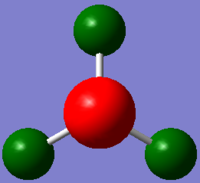 |
charge distributionColour range -1.000 to 1.000 | |
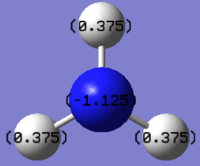 |
NBO charges for the nitrogen: -1.125 and hydrogen atom: 0.375 |
NH3BH3
NH3BH3 Optimisation
| File Name | SW_NH3BH3_OPT | |
|---|---|---|
| File Type | .log | |
| Calculation Type | FOPT | |
| Calculation Method | RB3LYP | |
| Basis Set | 6-31G(d,p) | |
| Change | 0 | |
| Spin | Singlet | |
| E(RB3LYP) | -83.22468910 | a.u. |
| RMS Gradient Norm | 0.00000031 | a.u. |
| Imaginary Freq | 0 | |
| Dipole Moment | 5.5646 | Debye |
| Point Group | C1 | |
| Job cpu time: 0 days 0 hours 0 minutes 25.0 seconds. |
NH<sub>3</sub>BH<sub>3</sub> Optimisation
Item Value Threshold Converged?
Maximum Force 0.000000 0.000002 YES
RMS Force 0.000000 0.000001 YES
Maximum Displacement 0.000005 0.000006 YES
RMS Displacement 0.000002 0.000004 YES
Predicted change in Energy=-3.646599D-12
Optimization completed.
-- Stationary point found.
----------------------------
! Optimized Parameters !
! (Angstroms and Degrees) !
-------------------------- --------------------------
! Name Definition Value Derivative Info. !
--------------------------------------------------------------------------------
! R1 R(1,7) 1.0185 -DE/DX = 0.0 !
! R2 R(2,7) 1.0185 -DE/DX = 0.0 !
! R3 R(3,7) 1.0185 -DE/DX = 0.0 !
! R4 R(4,8) 1.2098 -DE/DX = 0.0 !
! R5 R(5,8) 1.2098 -DE/DX = 0.0 !
! R6 R(6,8) 1.2098 -DE/DX = 0.0 !
! R7 R(7,8) 1.6677 -DE/DX = 0.0 !
! A1 A(1,7,2) 107.876 -DE/DX = 0.0 !
! A2 A(1,7,3) 107.876 -DE/DX = 0.0 !
! A3 A(1,7,8) 111.023 -DE/DX = 0.0 !
! A4 A(2,7,3) 107.876 -DE/DX = 0.0 !
! A5 A(2,7,8) 111.0227 -DE/DX = 0.0 !
! A6 A(3,7,8) 111.0228 -DE/DX = 0.0 !
! A7 A(4,8,5) 113.8738 -DE/DX = 0.0 !
! A8 A(4,8,6) 113.8739 -DE/DX = 0.0 !
! A9 A(4,8,7) 104.5973 -DE/DX = 0.0 !
! A10 A(5,8,6) 113.8739 -DE/DX = 0.0 !
! A11 A(5,8,7) 104.5975 -DE/DX = 0.0 !
! A12 A(6,8,7) 104.5974 -DE/DX = 0.0 !
! D1 D(1,7,8,4) -179.9991 -DE/DX = 0.0 !
! D2 D(1,7,8,5) -59.9992 -DE/DX = 0.0 !
! D3 D(1,7,8,6) 60.0009 -DE/DX = 0.0 !
! D4 D(2,7,8,4) -59.9991 -DE/DX = 0.0 !
! D5 D(2,7,8,5) 60.0008 -DE/DX = 0.0 !
! D6 D(2,7,8,6) -179.9991 -DE/DX = 0.0 !
! D7 D(3,7,8,4) 60.0008 -DE/DX = 0.0 !
! D8 D(3,7,8,5) -179.9992 -DE/DX = 0.0 !
! D9 D(3,7,8,6) -59.9991 -DE/DX = 0.0 !
--------------------------------------------------------------------------------
GradGradGradGradGradGradGradGradGradGradGradGradGradGradGradGradGradGrad
NH3BH3 Frequency
| File Name | SW_NH3BH3_freq | |
|---|---|---|
| File Type | .log | |
| Calculation Type | FREQ | |
| Calculation Method | RB3LYP | |
| Basis Set | 6-31G(d,p) | |
| Change | 0 | |
| Spin | Singlet | |
| E(RB3LYP) | -83.22468906 | a.u. |
| RMS Gradient Norm | 0.00000024 | a.u. |
| Imaginary Freq | 0 | |
| Dipole Moment | 5.5646 | Debye |
| Point Group | C1 | |
| Job cpu time: 0 days 0 hours 0 minutes 28.0 seconds. |
NH3BH3 Frequency Low frequencies --- -3.1658 -2.5379 0.0014 0.0015 0.0015 1.8917 Low frequencies --- 263.4226 632.9765 638.4394
NH3BH3
Association Energy
Association Energy of NH3+BH3->NH3BH3
Basis Set: 6-31G(d,p)
E(NH3)= -56.55776863 a.u.
E(BH3)= -26.61532364 a.u.
E(NH3BH3)= -83.22468906 a.u.
then still in AU compute the energy difference and report this on your wiki ΔE=E(NH3BH3)-[E(NH3)+E(BH3)] = -83.22468906-[(-26.61532364)+(-56.55776863)]= -0.05159679 a.u.
the final step is to convert the energy difference from AU to kJ/mol
1 a.u. = 1 hartree = 2625.50 KJ/mol
ΔE=-0.0516 a.u. *2625.50 kJ/mol = -135.47 = KJ/mol
So the dissociation energy is +135.47 KJ/mol, endothermic dissociation. this number tells us the association energy for combinging a molecule of NH3 with one of BH3, conversely it is also the dissociation energy!
Week 2: Project: Ionic Liquids: Designer Solvents
Part 1: Comparison of selected 'onium' cations'
Optimisation and frequency of [N(CH3)4]+, [P(CH3)4]+ and [S(CH3)4]+
| onium cations | [N(CH3)4]+ | [P(CH3)4]+ | [S(CH3)4]+ |
|---|---|---|---|
| File Name | SW_[N(CH3)4]+_OPT_freq | SW_[P(CH3)4]+_OPT_freq3 | SW_[S(CH3)3]+_OPT_freq |
| File Type | .log | .log | .log |
| Calculation Type | FREQ | FREQ | FREQ |
| Calculation Method | RB3LYP | RB3LYP | RB3LYP |
| Basis Set | 6-31G(d,p) | 6-31G(d,p) | 6-31G(d,p) |
| Change | 1 | 1 | 1 |
| Spin | Singlet | Singlet | Singlet |
| E(RB3LYP) (a.u.) | -214.18127521 | -500.82700333 | -517.68325777 |
| RMS Gradient Norm (a.u.) | 0.00004006 | 0.00001637 | 0.00004777 |
| Imaginary Freq | 0 | 0 | 0 |
| Dipole Moment (Debye) | 0.0004 | 2.8852 | 0.9653 |
| Point Group | C1 | C1 | C1 |
| Job cpu time | 7 minutes 31.2 seconds. | 7 minutes 12.1 seconds. | 3 minutes 39.2 seconds. |
| IR Spectrum | 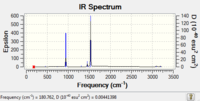 |
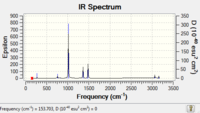 |
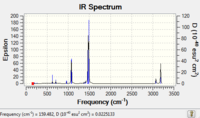
|
| Log file | [[N(CH3)4+ ]] | [[P(CH3)4+ ]] | [[S(CH3)3+ ]] |
| D Space file | [N(CH3)4+]] | [[P(CH3)4+]] | [[S(CH3)3+]] |
Optimisation of [N(CH3)4]+
Item Value Threshold Converged?
Maximum Force 0.000111 0.000450 YES
RMS Force 0.000028 0.000300 YES
Maximum Displacement 0.001413 0.001800 YES
RMS Displacement 0.000314 0.001200 YES
Predicted change in Energy=-1.051115D-07
Optimization completed.
-- Stationary point found.
Frequency of [N(CH3)4]+
Low frequencies --- -19.1188 -9.8202 -0.0009 -0.0006 -0.0001 21.7729 Low frequencies --- 180.8192 277.3212 288.7343
Optimisation of [P(CH3)4]+
Item Value Threshold Converged?
Maximum Force 0.000031 0.000450 YES
RMS Force 0.000012 0.000300 YES
Maximum Displacement 0.000856 0.001800 YES
RMS Displacement 0.000253 0.001200 YES
Predicted change in Energy=-3.411912D-08
Optimization completed.
-- Stationary point found.
Frequency of [P(CH3)4]+
Low frequencies --- -18.0294 -4.5198 -0.0036 -0.0032 0.0009 14.5481 Low frequencies --- 153.7212 183.3695 191.3300
Optimisation of [S(CH3)3]+
Item Value Threshold Converged?
Maximum Force 0.000158 0.000450 YES
RMS Force 0.000050 0.000300 YES
Maximum Displacement 0.000943 0.001800 YES
RMS Displacement 0.000280 0.001200 YES
Predicted change in Energy=-2.620616D-07
Optimization completed.
-- Stationary point found.
Frequency of [S(CH3)3]+
Low frequencies --- -29.1030 -19.8918 -0.0034 -0.0031 -0.0024 11.1429 Low frequencies --- 159.6295 192.4985 205.8541
Molecular Orbital of [N(CH3)4]+, [P(CH3)4]+ and [S(CH3)4]+
| onium cations | [N(CH3)4]+ | [P(CH3)4]+ | [S(CH3)4]+ |
|---|---|---|---|
| File Name | SW_[N(CH3)4]+_MO | SW_[P(CH3)4]+_MO | SW_[S(CH3)3]+_MO |
| File Type | .log | .log | .log |
| Calculation Type | SP | SP | SP |
| Calculation Method | RB3LYP | RB3LYP | RB3LYP |
| Basis Set | 6-31G(d,p) | 6-31G(d,p) | 6-31G(d,p) |
| Change | 1 | 1 | 1 |
| Spin | Singlet | Singlet | Singlet |
| E(RB3LYP) (a.u.) | -214.18127521 | -500.82698242 | -517.68325777 |
| RMS Gradient Norm (a.u.) | n/a | n/a | n/a |
| Imaginary Freq | n/a | n/a | n/a |
| Dipole Moment (Debye) | 0.0004 | 0.0021 | 0.9653 |
| Point Group | C1 | C1 | C1 |
| Job cpu time | 0 minutes 52.5 seconds | 1 minutes 15.4 seconds | 0 minutes 36.5 seconds |
| D Space file | [N(CH3)4+]] | [[P(CH3)4+]] | [[S(CH3)3+]] |
| Energy Level | [N(CH3)4]+ | Description |
|---|---|---|
| MO6: E=-1.19645 | 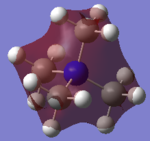 |
comment |
| MO9: E=-0.92555 | 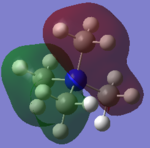 |
comment |
| MO10: E=-0.80747 | 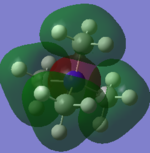 |
text |
| MO14: E=-0.62247 | 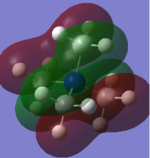 |
text |
| MO21: E=-0.57933 | 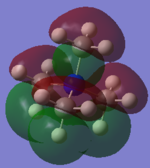 |
text |
Charge Distribution Analysis
Questions:
Using the NBO charge analysis compare and contrast the charge distribution across this trio of cations. How can your results be rationalised? reminder: NBO charges not Mulliken! charges should be tabulated, it is difficult to compare charges visually via the images. however images are useful in a qualitative way and when you include images of the charge ensure your charge range is the same accross all the images. This can be set by manually altering the range on the charge bar. Ask a demonstrator if you need help! Using the NBO population analysis compare and contrast the relative contribution of the C and heteroatom to the C-X bond. How do your results relate to the charge distribution just studied? [NR4]+ (R=alkyl) is often depicted as shown, with the positive charge placed on the nitrogen centre. Based on your results for [N(CH3)4]+, discuss the validity of the traditional description. You should consider the following: What does the "formal" positive charge on the N represent in the traditional picture? On what atoms is the positive charge actually located for this cation?
Part 2: Influence of functional groups
Optimisation and frequency of [N(CH3)3(CH2OH)]+ and [N(CH3)3(CH2CN)]+
| cations | [N(CH3)3(CH2OH)]+ | [N(CH3)3(CH2CN)]+ |
|---|---|---|
| File Name | SW_[N(CH3)3(CH2OH)]+_OPT_freq_vtight | SW_[N(CH3)3(CH2CN)]+_OPT_freq_vtight |
| File Type | .log | .log |
| Calculation Type | FREQ | FREQ |
| Calculation Method | RB3LYP | RB3LYP |
| Basis Set | 6-31G(d,p) | 6-31G(d,p) |
| Change | 1 | 1 |
| Spin | Singlet | Singlet |
| E(RB3LYP) (a.u.) | -289.39470636 | -306.39376141 |
| RMS Gradient Norm (a.u.) | 0.00000035 | 0.00000041 |
| Imaginary Freq | 0 | 0 |
| Dipole Moment (Debye) | 8.2355 | 8.6721 |
| Point Group | C1 | C1 |
| Job cpu time | 21 minutes 54.9 seconds. | 24 minutes 50.5 seconds. |
| IR Spectrum | 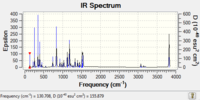 |

|
| Log file | [[N(CH3)3(CH2OH)+ ]] | [[N(CH3)3(CH2CN)+ ]] |
| D Space file | [[N(CH3)3(CH2OH)+]] | [[N(CH3)3(CH2CN)+]] |
Optimisation of [N(CH3)3(CH2OH)]+
Item Value Threshold Converged?
Maximum Force 0.000000 0.000002 YES
RMS Force 0.000000 0.000001 YES
Maximum Displacement 0.000005 0.000006 YES
RMS Displacement 0.000001 0.000004 YES
Predicted change in Energy=-2.728296D-13
Optimization completed.
-- Stationary point found.
Frequency of [N(CH3)3(CH2OH)]+
Low frequencies --- -9.6930 -7.6045 -4.7654 -0.0004 -0.0001 0.0005 Low frequencies --- 130.7079 213.6972 255.6339
Optimisation of [N(CH3)3(CH2CN)]+
Item Value Threshold Converged?
Maximum Force 0.000000 0.000002 YES
RMS Force 0.000000 0.000001 YES
Maximum Displacement 0.000003 0.000006 YES
RMS Displacement 0.000001 0.000004 YES
Predicted change in Energy=-3.560461D-13
Optimization completed.
-- Stationary point found.
Frequency of [N(CH3)3(CH2CN)]+
Low frequencies --- -4.7020 -4.2767 -0.0012 -0.0009 -0.0003 4.5253 Low frequencies --- 91.5853 153.8209 211.2666
Molecular Orbital of [N(CH3)3(CH2OH)]+ and [N(CH3)3(CH2CN)]+
| cations | [N(CH3)3(CH2OH)]+ | [N(CH3)3(CH2CN)]+ |
|---|---|---|
| File Name | SW_[N(CH3)3(CH2OH)]+MO | SW_[N(CH3)3(CH2CN)]+MO_vtight |
| File Type | .log | .log |
| Calculation Type | SP | SP |
| Calculation Method | RB3LYP | RB3LYP |
| Basis Set | 6-31G(d,p) | 6-31G(d,p) |
| Change | 1 | 1 |
| Spin | Singlet | Singlet |
| E(RB3LYP) (a.u.) | -289.39471123 | -306.39377029 |
| RMS Gradient Norm (a.u.) | n/a | n/a |
| Imaginary Freq | n/a | n/a |
| Dipole Moment (Debye) | 2.1359 | 5.7642 |
| Point Group | C1 | C1 |
| Job cpu time | 1 minutes 25.5 seconds. | 1 minutes 38.8 seconds. |
| D Space file | [[N(CH3)3(CH2OH)+]] | [[N(CH3)3(CH2CN)+]] |
Charge Distribution Analysis
Reference
1. L. C. Allen, J. Am. Chem. Soc., 1989, 111:9003
2. Kagaku Benran, CRC Handbook of Chemistry and Physics, 87th Edition, 1984, 2, 649–661

